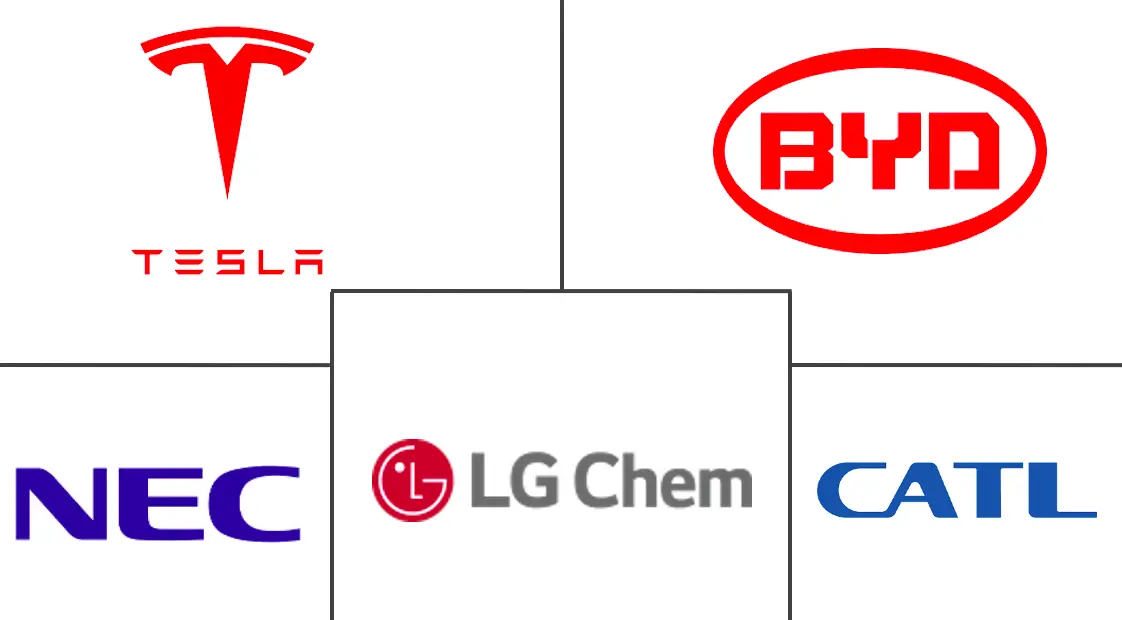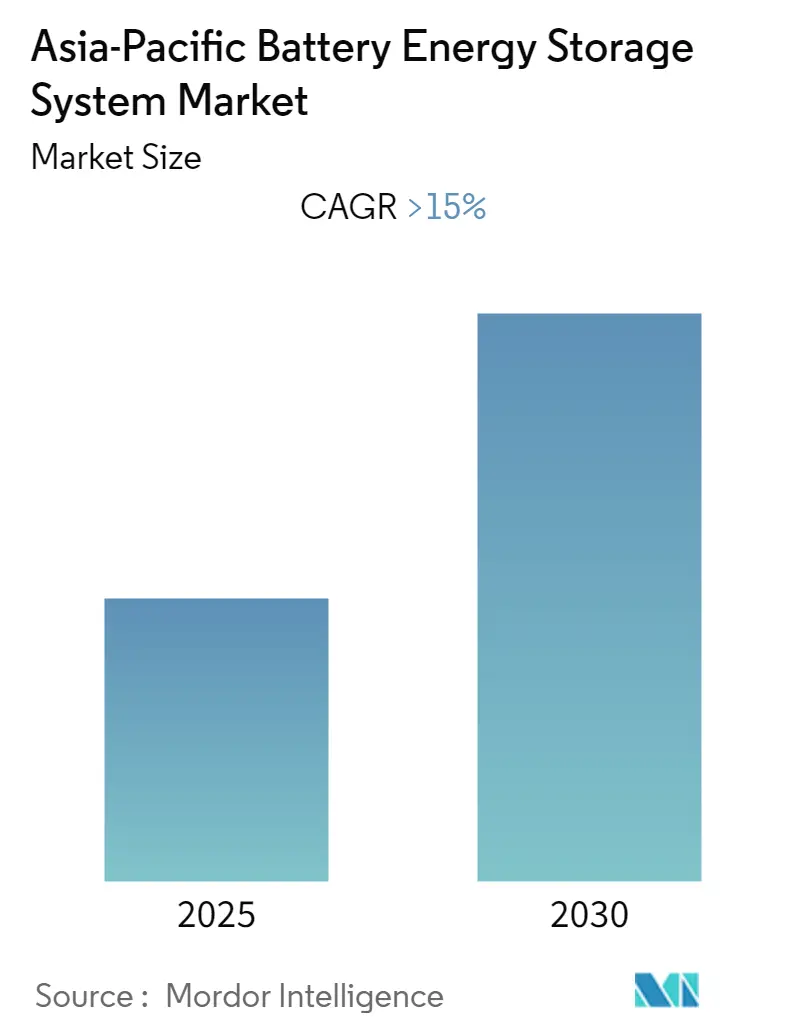
Asia-Pacific Battery Energy Storage System Market Analysis by Mordor Intelligence
The Asia-Pacific Battery Energy Storage System Market is expected to register a CAGR of greater than 15% during the forecast period.
The market was Moderately impacted by COVID-19 in 2020. Currently. The market has reached pre-pandemic levels.
- Over the long term, factors such as the increasing levels of renewable energy penetration and demand for reliable and uninterrupted power supply across the region are expected to drive the market during the forecast period.
- On the flip side, the high initial investment required for installing the battery energy storage system and the availability of alternative storage systems such as pumped hydro is expected to hinder the growth of the market studied.
- Nevertheless, the development of new battery chemistries, which can further reduce costs, is expected to provide a significant opportunity for the market during the forecast period.
- India is to witness significant growth in the Asia-Pacific battery energy storage system market due to a substantial rise in investment in data centers and the renewable energy sector, which depends on battery energy storage systems.
Asia-Pacific Battery Energy Storage System Market Trends and Insights
Commercial Sector to Witness Significant Growth
- Utilities can use batteries to store electricity during periods of low demand and tap the stored energy during peak periods to shave peak loads. The demand for energy storage systems in the utility sector is expected to increase in the future due to technical advantages and decreasing prices of energy storage systems.
- The commercial segment has recently been explored by project developers, for whom it constitutes a significant growth opportunity. Critical factors like increasing energy bills and price volatility are expected to drive the segment's growth in the coming years.
- Regions like Asia-Pacific are also seeing rapid population growth and urbanization, increasing the electricity demand. Renewable energy is becoming increasingly cost-effective, and developing countries are expected to add renewable energy to their grid. As of 2021, the Asia-PAcific region's renewable energy generation stood at 1690.1 TWh, doubling in the last five years from 805.1 TWh in 2017.
- Also, many areas are expected to adopt a more distributed approach to grid development, using more local power generation and microgrid systems and thereby creating a potential for growth of the battery energy storage system market in the region.
- Driven by strong growth in China and India, the commercial and industrial storage segment is expected to reach 9 GW by 2025. due to these, there is high demand for battery energy storage systems from the commercial and industrial sectors.
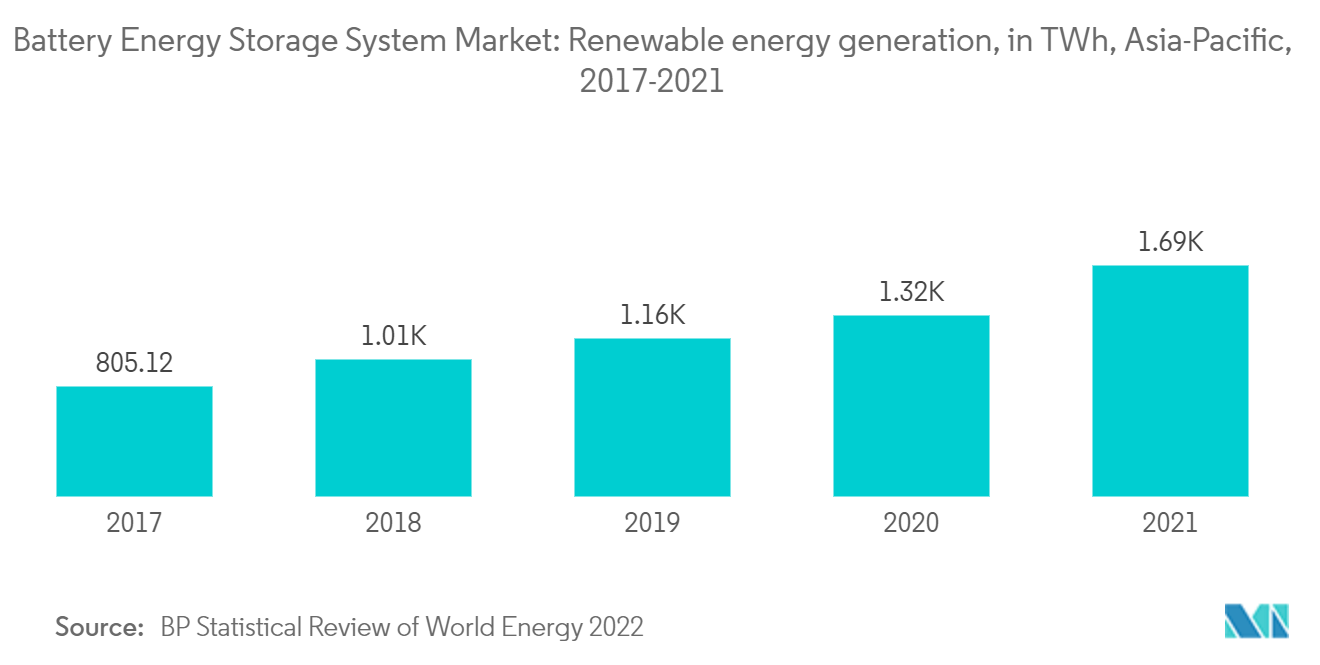
India to Witness Significant Growth in the Market
- The India Energy Storage Alliance (IESA) has estimated over 70 GW and 200 GWh of energy storage opportunities in India in the coming year, which is one of the highest in the world. Out of 70 GW, over 35 GW of demand is expected from newer applications like solar integration. Hence there is a sizable opportunity for advanced storage technologies in the new applications.
- In August 2022, JSW Energy secured 500 MW/1 GWh of battery energy storage system projects from Solar Energy Corp. of India and set up the battery energy storage system (BESS) in Rajasthan, close to the Fatehgarh-III substations of the interstate power transmission system.
- Moreover, India may also emerge as the third-largest energy storage installation country by 2040, i.e., energy storage installations worldwide are expected to multiply exponentially, from a modest 9 GW/17 GWh deployed as of 2018 to 1,095 GW/2,850 GWh by 2040.
- Therefore, with the growing renewable sector, the demand for the battery energy storage system to address the challenges related to intermittency in renewable power generation is expected to grow.
- One of the primary factors driving the growth of the Battery Energy storage systems market in India is the growth of the renewable energy market. As of 2021, India is the 2nd largest renewable energy market in the region, and the installed renewable energy capacity has grown steadily, from 105.25 GW in 2017 to 147.12 GW in 2021.
- As variable renewable energy sources such as wind and solar are inherently variable, so cannot be directly integrated into the primary energy grid without risking grid instability and need to be paired with Battery Energy Storage systems to store excess generation and stabilize the grid by providing frequency regulation and ancillary services. Hence, as India installs more renewable energy capacity, the demand for Battery Energy Storage systems is also expected to increase steadily during the forecast period.
- Hence, based on the above-mentioned factors, India is expected to witness significant demand for the energy storage systems market in the Asia-Pacific region.
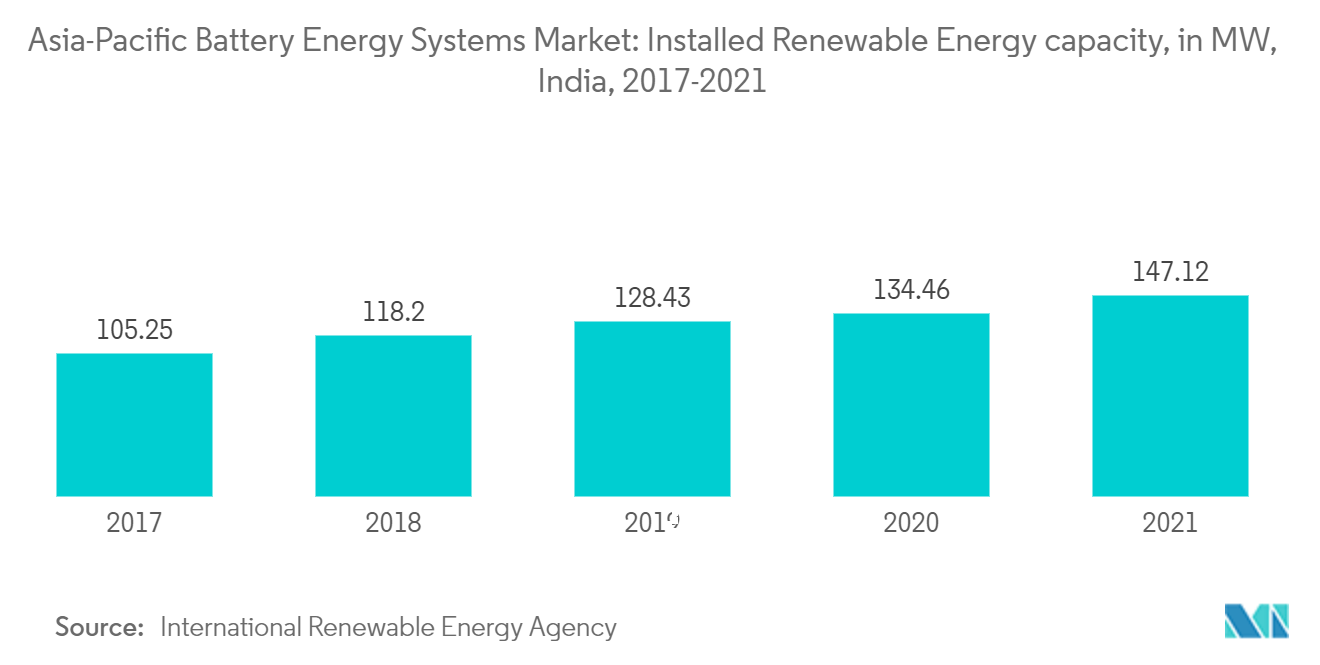
Competitive Landscape
The Asia-Pacific battery energy storage system market is moderately consolidated. Some of the key players in this market (in no particular order) include BYD Company Limited, LG Chem Ltd, Contemporary Amperex Technology Co. Ltd, Tesla Inc., and NEC Energy Solutions Inc., among others.
Asia-Pacific Battery Energy Storage System Industry Leaders
BYD Company Limited
LG Chem Ltd
Contemporary Amperex Technology Co. Ltd
Tesla Inc
NEC Energy Solutions Inc
- *Disclaimer: Major Players sorted in no particular order
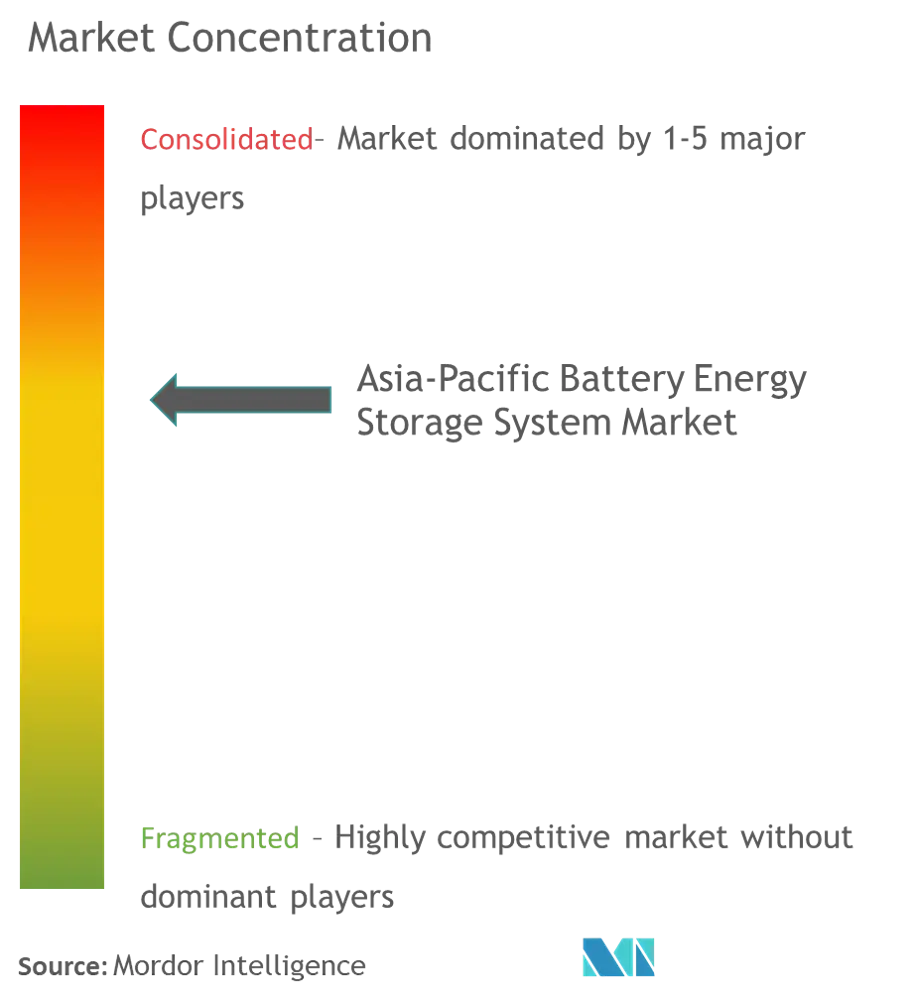
Recent Industry Developments
- In December 2022, the Australian government announced that eight large batteries to store renewable energy would be built around Australia to support the grid and help keep energy prices down. Nearly USD 120 million in funding for the projects will be provided by the government-owned Australian Renewable Energy Agency (Arena). The batteries will be located in Gnarwarre, Moorabool, and Mortlake in Victoria, Mount Fox and Western Downs in Queensland, Liddell in New South Wales, and Bungama and Blyth in South Australia. These batteries will range from 200-300 MWh each, have grid-forming inverter technology and are expected to come online by 2025.
- In March 2022, Indonesia's state-owned utility PLN signed an agreement with the Indonesia Battery Corporation (IBC) to launch a 5MW battery energy storage system (BESS) pilot project.
Asia-Pacific Battery Energy Storage System Market Report Scope
Battery Energy Storage system is defined as devices enabling energy from renewables, like solar and wind, to be stored and released when customers need power most.
The Asia-Pacific battery energy storage system market is segmented by technology type, application, and geography. By technology type, the market is segmented into lithium-ion batteries, lead-acid batteries, nickel metal hydride, and others. By application, the market is segmented into residential, commercial, and industrial. The report also covers market size and forecasts for the Asia-Pacific battery energy storage system market across major countries. For each segment, the market sizing and forecasts have been done based on revenue (USD Billion).
| Lithium-ion Batteries |
| Lead-Acid Batteries |
| Nickel Metal Hydride |
| Others |
| Residential |
| Commercial |
| Industrial |
| China |
| India |
| Japan |
| South Korea |
| Rest of Asia-Pacific |
| Technology Type | Lithium-ion Batteries |
| Lead-Acid Batteries | |
| Nickel Metal Hydride | |
| Others | |
| Application | Residential |
| Commercial | |
| Industrial | |
| Geography | China |
| India | |
| Japan | |
| South Korea | |
| Rest of Asia-Pacific |
Key Questions Answered in the Report
What is the current Asia-Pacific Battery Energy Storage System Market size?
The Asia-Pacific Battery Energy Storage System Market is projected to register a CAGR of greater than 15% during the forecast period (2025-2030)
Who are the key players in Asia-Pacific Battery Energy Storage System Market?
BYD Company Limited, LG Chem Ltd, Contemporary Amperex Technology Co. Ltd, Tesla Inc and NEC Energy Solutions Inc are the major companies operating in the Asia-Pacific Battery Energy Storage System Market.
What years does this Asia-Pacific Battery Energy Storage System Market cover?
The report covers the Asia-Pacific Battery Energy Storage System Market historical market size for years: 2021, 2022, 2023 and 2024. The report also forecasts the Asia-Pacific Battery Energy Storage System Market size for years: 2025, 2026, 2027, 2028, 2029 and 2030.
Page last updated on:
Asia-Pacific Battery Energy Storage System Market Report
Statistics for the 2025 Asia-Pacific Battery Energy Storage System market share, size and revenue growth rate, created by Mordor Intelligence™ Industry Reports. Asia-Pacific Battery Energy Storage System analysis includes a market forecast outlook for 2025 to 2030 and historical overview. Get a sample of this industry analysis as a free report PDF download.
